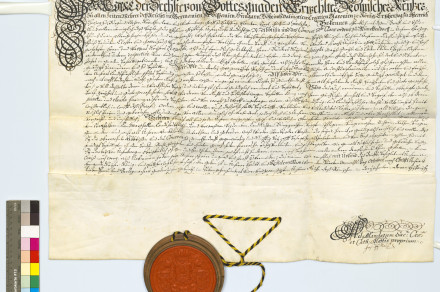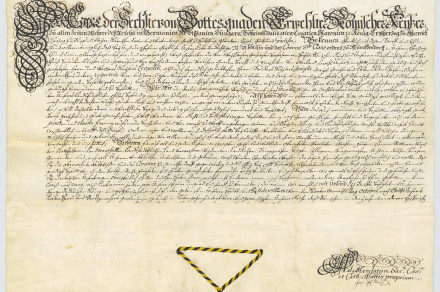Confirming of the Privileges Granted to the Poor Clare Convent in Mekinje/Minkendorf
1724, October 4, Vienna
Original, parchment, 72 x 52 cm, round pendant seal of Emperor Charles VI of Habsburg, made of red wax, 11.5 in dimeter in rounded wooden cup, 15 cm in diameter, attached with yellow-black silk string
Reference code: SI AS 1063, Zbirka listin, št. 5224

Charter with the seal of Emperor Charles VI. Habsburg, confirming the privileges of the Monastery of the Clergy of Mekinje. | Author Archives of the Republic of Slovenia
In 1212, three years after he founded the Order of Friars Minor for men, St. Francis of Assisi also founded an order for women and named it the Order of Saint Clare or the Poor Clares (Ordo Sanctae Clarae – OSC). The order was named after the noblewoman Clare de Offreduccio, known as St. Clare of Assisi, who, at the age of eighteen, chose to live a life of chastity, obedience to God and strict poverty, which was rather unusual for the time. She abandoned »the comfort and splendour of the world« in order to »follow the crucified Christ and love him with all her being«. She chose prayer, silence, contemplation, love of God and complete servitude to God. In 1212/1213, St. Frances compiled rules (Rule of St. Clare) for the Poor Clares, outlining how the nuns should live. Some of these rules, however, were later somewhat relaxed (the nuns were, for example, allowed to receive regular income and have a common property which they were free to manage). In 1253, Pope Innocent IV (1243-1254) with his papal bull Solet annuere confirmed the original text of the Rule of St. Clare, which called for absolute poverty, but in 1263, Pope Urban IV (1261-1264) with his bull Religionis augmentum somewhat relaxed these rules and allowed the Poor Clare convents to have larger estates.
Between 1300 and 1782, the Poor Clares founded six convents in the Slovenian ethnical territory, three of them in Carniola. The oldest and the most important among them was the convent in Mekinje near Kamnik (Minkendorf near Stein) (1300-1782). At different times other Poor Clare convents were also active in Koper (1299/1301-1806), Šentvid ob Glini (Sankt Veit an der Glan) (1321/1323-1553/1554), Škofja Loka (1358-1782), Gorica (1653-1782), and Ljubljana (1657-1782).
The convent in Mekinje, officially known as the Convent of St. Mary of the Assumption of the Order of St. Clare in Mekinje, Carniola, was founded by Siegfried and Elisabeth Gallenberg (of Mekinje) on October 9, 1300. They provided accommodation for the nuns and ensured their material sustenance. Upon founding of the convent, they also donated to the nuns 13 farms, 4 cheese dairies, several pastures, orchards and streams, as well as the right to collect wood in the forest near Kamniška Bistrica (Steiner Feistritz). The latter privilege then became the core of the dispute between the Poor Clares and the town of Kamnik for over 200 years. Unlike other Poor Clare convents, the building in Mekinje was located outside the town, and housed the so-called urban Poor Clares, who could own large estates, which often hindered their monastic life.
At first, the Mekinje convent could accommodate only 13 nuns, but as time went by that number changed (when the convent was dissolved in 1782, there were 20 nuns in residence). Girls that entered the convent were daughters of the most prominent Carniolan noble and bourgeois families; some also came from Styria, Carinthia and the Gorizia region. The convent was led by abbesses, who were prelates by position and could therefore attend the sessions of the Carniolan Provincial Diet through their representatives. As far as their spiritual care was concerned, the Poor Clares were initially subordinate to the Minorites in Ljubljana, but from 17th century on, the responsibility for their spiritual care was taken over by the Franciscans in Kamnik.
Although the convent expanded its land by numerous new purchases and donations, the neighbouring convents (such as the Domenican convent in Velesovo/Michelstetten) seemed to be more successful at it. The Poor Clares had some of their largest land in the east Upper Carniola, between Velesovo and Zagorje ob Savi. They repaid their benefactors by holding mass offerings, commemorating anniversaries of deaths, but most of all by offering much needed prayer, which the world outside the convent’s wall always seemed to lack time for. As in other convents, the nuns in the Mekinje devoted their time also to educating girls from noble and bourgeois families.
At the end of August 1338, the convent was pleased to be granted the right by the Austrian Duke Albrecht II (1330-1358) to exercise lower or patrimonial jurisdiction over its subjects. Their subjects lived considerably better than those on the neighbouring estates that were owned by individual noble families. This is likely the reason why there are almost no reports of peasant uprising within the territory of the convent. The convent also survived Turkish invasions of Carniola relatively well; it was attacked and plundered by the Turks only once, in 1471, but during that attack all the nuns there were reportedly taken into slavery, so the convent needed new nuns to move in.
After 1681, when the Gellenbergs finally settled the dispute about the hereditary advocacy over the convent, they went on to undertake a thorough renovation of the convent’s dilapidated, until then still wooden, building. After the renovation was finished in 1686, Johann Weichard Valvasor described it as the most beautiful convent in Carniola. Its glory, however, lasted less than a hundred years. Like many other monasteries “that did nothing to contribute to the good of the state”, the convent in Mekinje was also dissolved, following the decree issued on January 12, 1782 by Emperor Joseph II (1765/1780-1790). The Poor Clares left the convent on July 1, 1782. Most of them came to the former Dominican convent in Velesovo, which was a so-called central monastery for the nuns from the dissolved Upper Carniola convents, i. e. for the Poor Clares from Mekinje and Škofja Loka/Bischoflack and for the Dominican nuns from the convent in Velesovo. This was the end of almost five-hundred-year long economic, cultural and spiritual life north of Kamnik. The convent came to life again in 1902, when the Ursulines moved into the building, but it died down completely in 2016, when the Ursulines, no longer able to carry the huge financial burden of renovating and maintaining the complex, donated the convent to the municipality of Kamnik. Today, the former convent houses the Public Institution for Culture Kamnik.
Presented here as this month’s archivalia is a charter issued by Emperor Charles VI of Habsburg (1711-1740), which today is preserved among other charters of the Poor Clare convent in Mekinje in the Collection of charters (SI AS 1063) kept by the Archives of the Republic of Slovenia. On October 4, 1724, some 300 years ago, the ruling lord and Carniolan prince Emperor Charles VI of Habsburg issued a charter, written in Vienna upon the humble request of the abbess and the convent of St. Clare in Mekinje in the Dutchy of Carniola (N. äbbtisin und das convent sanctae Clarae ordens zu Münckhendorff in unserem herzogthumb Crain). By means of this charter Emperor confirmed the convent's earlier rights, freedoms and good habits (alt herhabende recht, freyheiten vnd guete gewohnheiten) that had previously been confirmed by Emperor’s deceased predecessors, but he did add an interesting note: »so vill daßelbe deren in würckhlicher besiz- und üebung ist«. This was the second to last confirmation of the privileges before the convent was dissolved in 1782; the last such privilege was issued by his daughter Maria Theresa on the last day of July 1761.
Jure Volčjak
- Hančič, Damjan: Klarise na Kranjskem (Gradivo in razprave 26). Ljubljana: Zgodovinski arhiv, 2005.
- Hančič, Damjan: Samostan Mekinje – 700 let. Mekinje: Krajevna skupnost, 2000.
- Milkowicz, Wladimir: Die Klöster in Krain. Studien zur österreichischen Monasteriologie. Wien: Carl Gerold's Sohn, 1889.
- Mekinje Monastery website.



